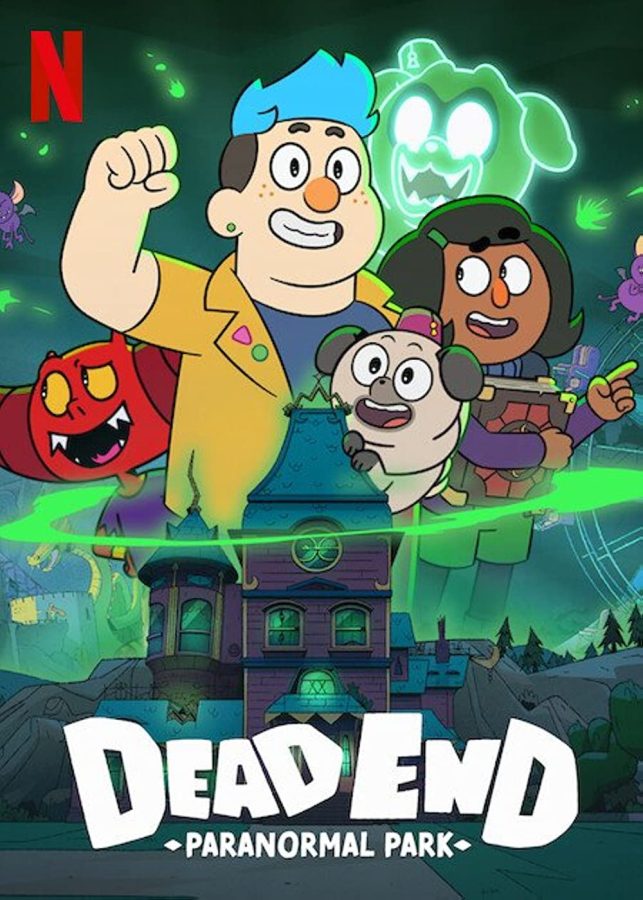Dead End: The Show We’ve Been Waiting For
In recent years, LGBTQIA+ representation in the media has grown, especially in cartoons and animated series. Shows like She-Ra and The Owl House have done an incredible job of bringing queer characters into the spotlight, something that is especially important in kids media; however, I find that in these shows, the writing, humor, and plot is often more targeted towards a young adult audience and less towards kids under the age of 10. There is one show, though, that remains underappreciated in the field of children’s animation that succeeds in appealing to the latter audience: Dead End: Paranormal Park.
Season one of Dead End: Paranormal Park, or Dead End for short, is about two teens (Barney and Norma) navigating their first job experience at a thrill-inducing, mystery-filled theme park. The park is a tribute to Pauline Phenix, a deceased fictional celebrity who emanates the persona of a drag queen. Throughout the season Barney and Norma are joined by Barney’s dog Pugsly and a 1000-year-old demon as they fight zombies, ghosts, and game show hosts.
What I love about Dead End is how the show highlights the characters’ identities without making them the entire plot, mainly with Barney being trans-masculine. While Barney’s identity is made very clear, it is not the main focus of the series; Dead End explores Barney as a fully rounded character and not just as a trans teen. We see him as an older brother, a friend, and most importantly just as a teenager. We see him develop a crush, work his first job, and struggle with his parental relationships. This point was really driven home in a scene where Barney comes out to Norma. “I’m trans, Norma,” he says. “Everyone at school knows, and everyone at home knows, and being here, it’s like a whole new place. I can just be Barney.” This is not the voice of a trans teen struggling to find his identity; this is the voice of someone who wants to be a person not fully defined by their trans identity.
Dead End also offers one of the most diverse casts of characters in a children’s animated show. With Barney being trans and gay, Norma being Pakistani-American as well as autistic, and two other teenage workers at the park, Lincoln and Badyah, being Vietnamese-American and Iranian-American respectively, this story paints an accurate, inclusive representation of the mixed, queer, and neurodivergent identities of today.
Season One was an absolute masterpiece of animation, so when Season Two of Dead End: Paranormal Park released on October 13, it’s needless to say I was extremely excited to see how the story would continue; and let me tell you, it did not disappoint. As an avid watcher of anything animated, I am in awe of what this show has done. With the second season, Dead End thickens a plot so intriguing you can’t help but watch one episode after the other until you realize the season is over. For a show that only had a four month break between the release of Season One and that of Season Two, everything is beautifully crafted. From the storyline to the character development, this show gets absolutely everything right.
The development of each character gets a heavy focus on this season, which made me incredibly happy because I got to see moments on screen that were representative of real life. Barney finds a gym where he doesn’t have to answer questions about his appearance or his weight or his binder, a comfort that is sometimes hard to find for trans individuals. Norma realizes she’s bisexual and struggles with coming out to her mom, leading to a conversation about coming out to Asian parents. This season was scattered with the concept of maintaining boundaries within relationships, whether they be romantic, platonic, or familial. The characters of Dead End seem like people you could meet in your everyday life; I saw this through Lincoln trying and failing to land acting parts, Norma having an overstimulation-based panic attack, and even through Courtney, a demon, trying to figure out where she’s from. The characters’ internal struggles with identity and relationships turn them into people you can understand and root for because many audience members see parts of themselves in the show.
In the Tatler poll I asked, “Have you ever seen a trans character in a kids TV show?” Out of 104 respondents, only 26% said they had. This is why shows like Dead End – that simultaneously cater to a younger audience but remain suitable for anyone to watch – are important: It’s hard in today’s world to find a series that has gender, race, and sexuality diversity ingrained in the show without it being the entire plot. There are other shows that do this well, but don’t have a plot entirely understandable for younger ages. Overall, I think that Dead End is an absolute gem in the ever-evolving world of animation, so if you’re looking for a spooky show with a diverse cast of characters and a truly interesting plot, Dead End: Paranormal Park might just be the show for you.
Cassia W. from the class of ’23
They’re lots of fun and number one, on that, we all agree
Only been here a semester but they’re spilling all the...

